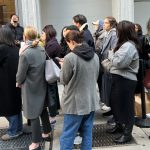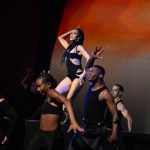A connection to place was also seen in designers’ use of “home textiles.” Antique linens inspired some of the white work techniques applied to subtly seductive pieces at The Garment where the dual roles of women were explored. Also homey was pajama dressing, and prints featuring food and tableware that referenced the hyggeligt lifestyle celebrated in publications like Kinfolk. Bonnets and headscarves referred back to the rural agricultural roots of the Nordics, and round hardware fastenings and pendants nodded at Viking tradition.
The “shiny, happy” narrative spun around CPHFW, perhaps the most Instagrammable of the fashion weeks, was not abetted by the sun this season. If spirits were high, skies were gray. Variable weather is the reality in this part of the world, not the exception, which might explain why layering is such an important aspect of Scandi-style. For spring, Danish designers offered a master class on how to wear skirts or dresses over pants, tanks over shirts, and tees over blazers. “More Is More” is the slogan for this year’s Copenhagen Opera Festival, but it could be applied, in a broad stroke to Danish fashion, which is defined by color, print, and a kind of arty individualism more so than strict minimalism.
Denim is the core of a contemporary and casual wardrobe and this season many designers translated the “Canadian tuxedo” into denim sets. At Sunflower, Laid Back performed their 1983 chart-topper “White Horse” while models sported Age of Aquarius-style jeans.



